Please use the following link to download the March 18, 2023 issue of the syəcəb
Gambling Addiction
Submitted by Sarah Sense-Wilson
Gambling addiction is an illness, not a financial problem.
It starts out as a recreational activity and progresses to a compulsive behavior, which becomes the main focus of a gambler’s life.
Compulsive gambling has mental, physical, emotional and spiritual manifestations and consequences.
The main symptom of this addiction is denial and the major characteristics are loss of control, preoccupation, chasing the losses and continuing despite negative consequences.
Anxiety and depression, low self-esteem and immaturity often underlie this addiction. However, the person has to stop gambling first before they can be helped with any other issues.
Gambling addiction has a devastating effect on family life and relationships.
Definition
Compulsive gambling is a progressive illness, which starts out as a recreational activity and ends up being destructive to both the gambler and his/her families. Compulsive gambling has mental, physical,emotional and spiritual consequences. The main symptom of this addiction is denial and the major characteristic is loss of control. There is also a tendency to take bigger and bigger risks as time goes by.
Like alcoholism, it is an illness, which cannot be cured, but which can definitely be arrested. One of the main symptoms of gambling addiction is that it becomes an overriding passion that permeates all aspects of the gambler’s life. Inability to stop gambling and continuing to gamble despite negative consequences are also characteristics of gambling addiction.
Winning, losing and desperation are the three phases of compulsive gambling. There are both social and economic costs involved when someone is addicted to gambling. These include poverty, starvation, family disintegration and criminal behavior. People who gamble to excess often suffer from feelings of depression and anxiety, as well as muscular tension, fatigue, headaches and high blood pressure.
Employees who have a gambling addiction also do not perform well at work as they are preoccupied with the next bet, money problems, where to get money, etc. Engaging in criminal activities in order to fund the gambling habit becomes a reality for many gambling addicts.
Gambling addiction is something that can happen to anybody.
Test yourself
Below are 10 questions from the US National Council on Problem Gambling on gambling behavior.
- Have you often gambled longer than you had planned?
- Have you often gambled until your last cent was gone?
- Have thoughts of gambling caused you to lose sleep?
- Have you used your income or savings to gamble while letting bills go unpaid?
- Have you made repeated, unsuccessful attempts to stop gambling?
- Have you broken the law or considered breaking the law to finance your gambling?
- Have you borrowed money to finance your gambling?
- Have you felt depressed or suicidal because of your gambling losses?
- Have you been remorseful after gambling?
- Have you gambled to get money to meet your financial obligations?
If you or someone you know answers “Yes” to any of these questions, consider seeking assistance from a professional regarding this gambling behavior. For a variety of treatment services contact Tulalip Tribes Family Services Problem Gambling Program at (360)716-4304 or Washington State Helpline 1-800-547-6133
MSD round dance celebrates Native cultureMSD round dance celebrates
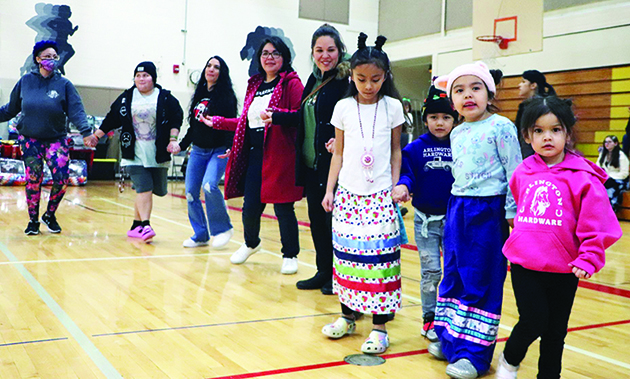
By Shaelyn Smead, Tulalip News
A few things about Natives will always stay the same throughout time. One of the most important, we love to surround ourselves with our loved ones while we eat, sing, dance, and rejoice in our culture.
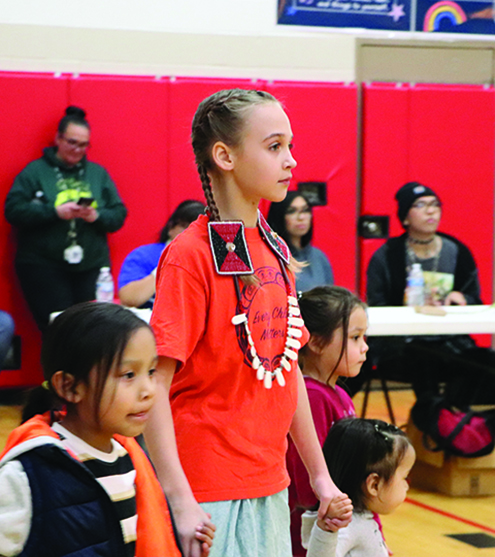
On March 9th, the Marysville School District Indian Education department held its annual round dance. Natives of surrounding tribes joined tribal and community members to embrace the lively cultural evening. The festivities began with a shared meal, followed by singing, dancing, communal conversations, and shopping from local Native vendors and artists selling handmade pieces like ribbon skirts, cedar headbands, and jewelry.
In typical round dance style, drummers and singers gathered in the middle of the room while dancers shuffled clockwise in a circle around them. With many tribes represented that night, traditional tribal songs and regalia from throughout Washington were adorned and admired for people to see and hear.
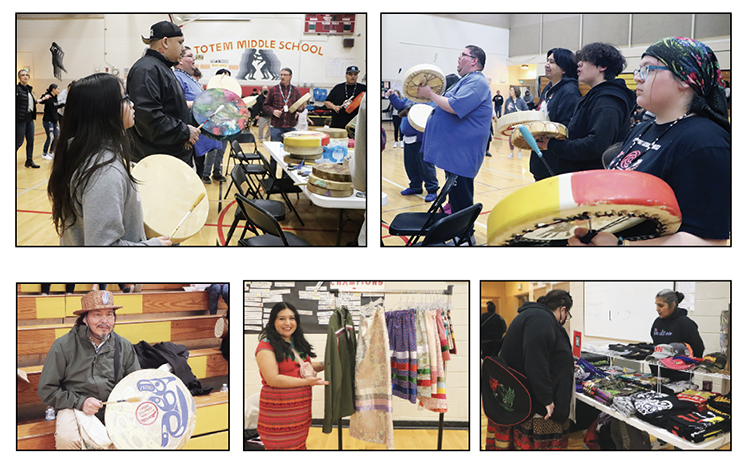
The round dance even had a surprise guest, newly appointed MSD Superintendent Dr. Zachary Robbins. Several people gathered beside him to teach the basic steps and meaning behind the movements. With a smile, Dr. Robbins quickly picked up the moves and danced alongside community members for a few songs.
Other than the many rich cultural elements demonstrated at the event, was pure comradery between the people who attended. MSD Native American Program Coordinator Matt Remle said, “The round dance was a beautiful evening of bringing together our families, youth, elders, community members, and district staff to enjoy and celebrate life. It was good to see the smiling faces, laughter, and sharing in our cultural ways of life.”
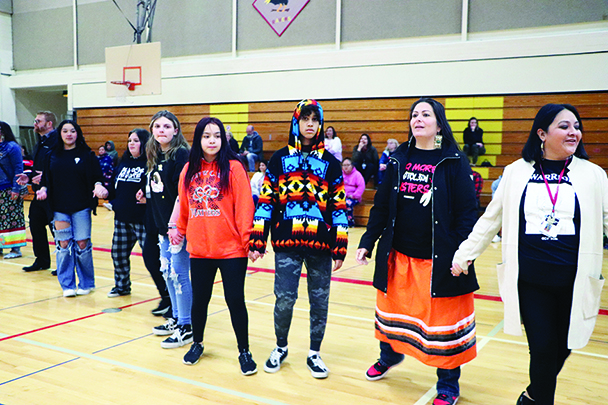
Women Warriors
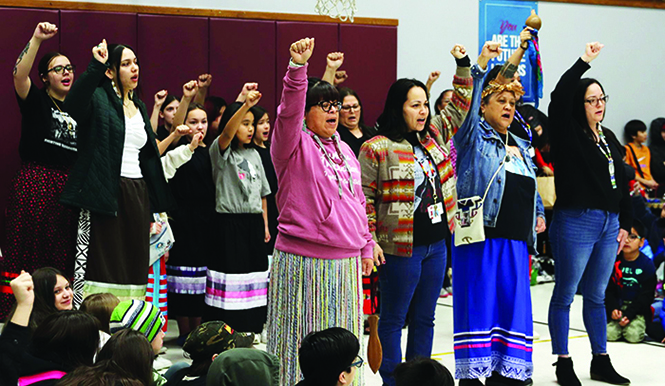
By Kalvin Valdillez, Tulalip News
Tulalip women are strong, assertive, confident, knowledgeable, caring, resilient, proud, hilarious, and inspiring. They played a key role in shaping Tulalip into the thriving community that it is today by keeping the culture alive and growing both the governmental and gaming entities of the Tribe. Their contributions locally and nationally have assisted innumerable families and people throughout the years. And their kind and understanding hearts have helped many individuals overcome adversity and find their purpose in their respective tribal communities.
There are countless examples of current women leaders at Tulalip. Whether it’s Teri Gobin, Misty Napeahi, Debra Posey, or Pat Contraro on the Tribes Board of Directors, Jessica Bustad at the Education Division, Sheryl Fryberg at the Betty J. Taylor Early Learning Academy, Michele Balagot at the Lushootseed Language department, Jade Carela at the Legacy of Healing and Child Advocacy Center, Mytyl Hernandez at the Hibulb Cultural Center, Niki Cleary at Media & Marketing, Candy Hill at Funeral Services, Natasha Fryberg at beda?chelh, Marci Fryberg at TGO, or Tammy Taylor at Bingo, the women of Tulalip are at the helm and are steering the future of Tulalip to a brighter tomorrow.
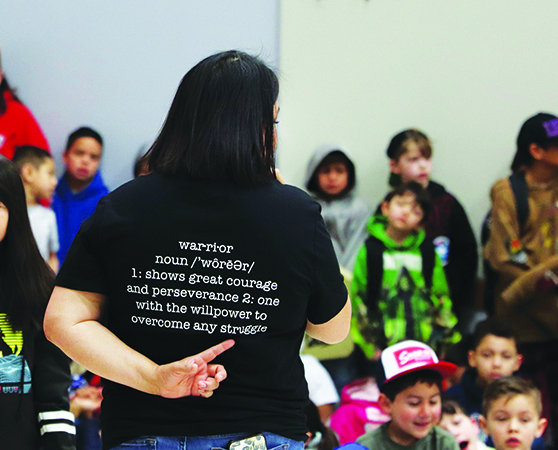
And that’s not to mention the countless women leaders who came before them, or the women who work within all the different departments of the Tribe, or the women who are active in the community – all of whom are making a huge impact in a good way for the well-being of Tulalip. What is even more astounding is the fact that with all the leaders listed above, there are even more women who aren’t mentioned that are doing important work for their people and community. And it goes without saying, because it is the Tulalip way, that each of these women are passing down their teachings and knowledge to the younger generations of Tulalip women, so they too can be strong leaders in the years to come.
When holidays such as Mother’s Day, International Women’s Day, and Women’s History Month are celebrated, it’s much more special to Indigenous communities who rely on the wisdom, love, and perspective of their matriarchs with every day that passes. And it is also the reason why the pain is much more severe when these amazing women make their journey to the afterlife or when they are pronounced missing from their homelands and communities.
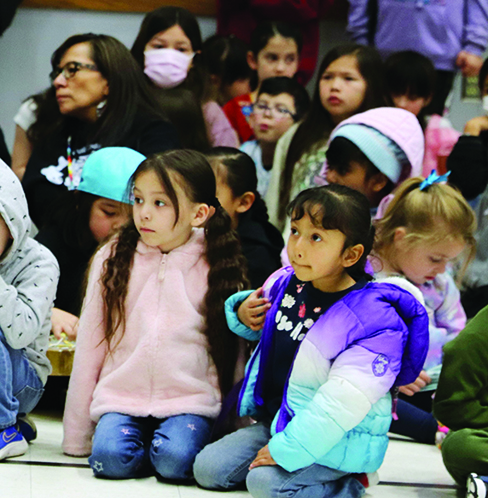
The work that Tulalip women are putting in hasn’t gone unnoticed. In fact, it is inspiring young ladies throughout the reservation. On the morning of March 10, the students of Quil Ceda Elementary (QCT) held a gathering to pay homage to the ‘Women Warriors’ of Tulalip. The powerful and moving ceremony was organized by QCT’s own Ms. Palacio, and she received a helping hand from a number of students dressed in colorful ribbon skirts, who are officially known at QCT as the Salish Sisters. Heartfelt words were spoken, and tears were shed during the morning assembly as the students and faculty of the school thanked all of Tulalip’s Women Warriors for setting a positive example for the future leaders of the Tribe.
To open the special tribute, a number of Tulalip students offered a few of the Tribe’s traditional songs, including the Women Warrior song. Guests of honor at the celebration included Deborah Parker and the women of the Aunties in Action collective for their outstanding work in uplifting the community of Tulalip, especially for the young Native women who are sure to follow their footsteps in leadership in the not-so-distant future.
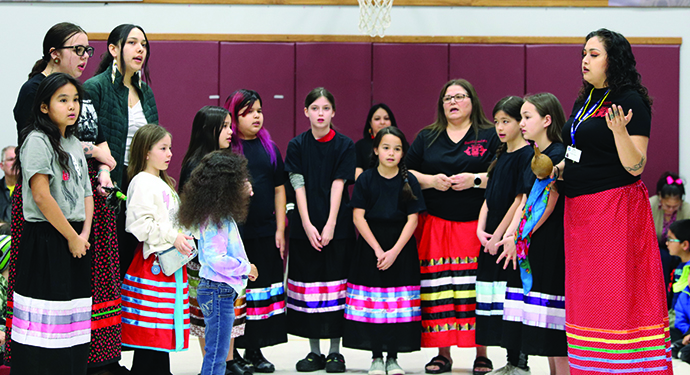
Deborah Parker and the Aunties in Action shared important messages with the students.
Deborah Parker, (Indigenous Activist and Chief Executive Officer of the National Native American Boarding School Healing Coalition)
“I thank the creator that I’m here with you, my children, and my community. With every breath that I have, I want to make sure that you know that you are loved. I want you to know that there are teachers surrounding you and parents who want to make sure you have a good education. But most of all that you feel loved, that you know how special you are, and that you know how much we care for each and every one of you. Thank you to our lady warriors who sang the Women Warrior song – that song is so special and important to us. This is the best advice I was given and I’m going to share it with you today, and that is to follow your spirit. Follow what you believe in your heart. And most importantly, treat each other with love and respect.”
Natosha Gobin (Aunties in Action)
“We want you guys to know that all of the work we do in the community, we do it because we want our community to be a better place. We want our families to be healthy, we want our children to be happy and healthy. Everything we do, we do it with each one of you in mind. We’re thinking about your families, thinking about some of the things you might need. And I just want you to know that we love you all.”
Zenitha Jimicum (Aunties in Action)
“Our Aunties in Action organization started because my cousin Tosha sent out a text during the pandemic that there was food to be donated and food to be distributed. Many of the adults remember that we had people who were laid off and were losing their jobs at this time, and parents were struggling on a daily basis. She gathered us together for our community. And that’s what I want to encourage you to do. As children you can still be leaders, you don’t have to wait to be adults. You can gather together and set goals today. I want to encourage you to build your leadership skills when you’re young and get more people to help, so we can continue to serve our people and so our community can stay strong.”
Monie Ordonia (Aunties in Action)
“We started from a place where we wanted to be of service to our people. We wanted to help our people feel better. When we distributed the food during the pandemic, I made sure I shared a smile and greeted everyone with love and respect. You can make others feel good any time by helping someone else. When we do that, we can help those people who are feeling sad or depressed, and we can create a space for them to know that they’re supported.”
Malory Simpson (Aunties in Action)
“I wanted to do my part to help bring our community together. A few years ago, we started the organization Together We’re Better because if we work together, we can do so many good things. When Aunties in Action was formed, it was so much fun. Through this work, we get to join together, spend time together. When we’re sad, we can reach out and talk to each other. It’s important to build those bonds with each other. Together, we can help build a better community. And for you kids, we love to see you come and join us in our activities. April 2nd we’re going to be doing an Easter Bunny run on the reservation, we’re going to be walking around the reservation with the Easter Bunny – we might have easter eggs, we might have candy. Today, I saw a little girl in her cedar belt – just beautiful. All you girls singing that song with us is just beautiful. Your culture is always going to be here for you, and we’re always going to be here to support you, and guide you, and teach you.”
Before they presented gifts to the guests of honor and headed back to their classrooms, the QCT students dedicated this special poem to all the Indigenous Women throughout history – past, present, and future :
Women Warriors
They are aunties, mothers, sisters, daughters, and wives. But above all, these women are warriors. We honor our ancestors with leadership in women that have made it crucial to the importance of our roles in our communities today. All across time, since we can remember, women have always reminded us of the importance of working together and caring for our children, as if they were their own. We care for the whole child today because it takes a village to take care of a child. We celebrate the women warriors who taught us this. Indigenous women who are now leaders of tomorrow. Through resiliency work they have changed the narrative and are impactful leaders.
RaeQuan leads Montana State to Big Sky championship, named tournament MVP

By Micheal Rios, Tulalip News; Photos courtesy Montana State Athletics
Flashback to the 2021-2022 basketball season. In his first year at Montana State University, after transferring from the University of Washington, Tulalip’s own RaeQuan Battle played the role of 6th Man. He was the first bench player into the game most nights. As a transfer, he was required to be patient while adjusting to his new role in a new system, implemented by his new coach on new team.
Biding his time watching and learning, RaeQuan continued to develop his overall game. Yet, at all times, he stayed ready with that thang on him. That thang being his ability to fire away from deep. Something that the entire collegiate sports landscape witnessed on March 5, 2022 when he hit a game-winning 3-pointer from deep that made Logo Lillard proud. His first game-winning bucket as a Montana State Bobcat ended up as ESPN’s top play of the day.
That singular play reminded all doubters, critics, and casuals of the singular talent RaeQuan possesses. It also propelled him to even higher standards befitting a number one option in his second year at MSU.

It’s almost an understatement to say the 6’5”, 190-pound shooting guard thrived during the 2022-2023 regular season. His game soared to new levels as he led his Bobcats squad in total minutes played, field goals made, and 3-pointers made. Playing a team high 29.6 minutes per game as a starter, Rae showcased his silky-smooth jumper while scoring a team high 17.4 points per game. By the numbers, his defense improved as well, while ranking third on his team in both steals per game and blocks per game.
Montana State finished the regular season with an impressive 14-2 clip over there final sixteen games. Included in that run was RaeQuan scoring a college career high 32 points on January 18 against Sacramento State. The Bobcats finished the regular season with a (22-9) record, good for the #2 seed in the Big Sky tournament.
In their opening game of the Big Sky tourney, Montana State secured an 84-73 win versus Northern Colorado. Then two days later, on March 7 versus Weber State, RaeQuan again made ESPN’s highlight reel with a dazzling display of athleticism and play call execution.
In double-overtime and only 13.4 seconds remaining, Montana State’s coach Danny Sprinkle drew up a play designed to get RaeQuan open along the baseline. The play worked to perfection as Weber State did indeed leave RaeQuan open, so open that he was able to slam home an emphatic dunk in front of a raucous fan base. Another W for MSU. Another game-winner for RaeQuan.

“I have about 7,000 text messages congratulating me on a great play call,” shared Coach Sprinkle after the thrilling double-overtime game that ended with a game-winning alley-oop from Darius Brown to RaeQuan. “But it wasn’t me. It was Rae. He called it.”
The Big Sky championship game pitted Montana State vs. Northern Arizona on March 8 and was televised on ESPN2 for the convenience of Tulalip households who tuned in to cheer on their beloved RezQuan. The Tulalip hooper who learned his love of the game at the local Boys & Girls Club put on an offensive showcase for the current crop of young Tulalips who dream of playing college basketball. He led all scorers with 25 points and, more importantly, led his Bobcats to an 85-78 win.
For the second consecutive season, Montana State men’s basketball claimed the title of Big Sky conference champions. Their lead scoring guard, who went from 6th man last season to offensive focal point this season, was named the tournament’s Most Valuable Player.
During the post-game press conference, RaeQuan was asked what’s the best part of winning Big Sky MVP? Without hesitation he responded, “That I won it with my team. I didn’t achieve this by myself. It took the entire team to get us [in this position] and I’m just happy I was able to win a championship ring with my best friend Jubrile and one of my favorite coaches all time, Coach Sprinkle.”
Just days ago, Montana State with their (25-9) record and Big Sky championship, was designated the #14 seed in the East Region during the NCAA Tournament selection show. The Bobcats will face #3 seed Kansas State (23-9) on Friday at 6:40pm.in the opening round held in Greensboro, North Carolina. As part of March Madness, the game will be nationally televised on CBS.
March 11, 2023 syəcəb
Please use the following link to download the March 11, 2023 issue of the syəcəb
Next generation gaming computers open new world of opportunity
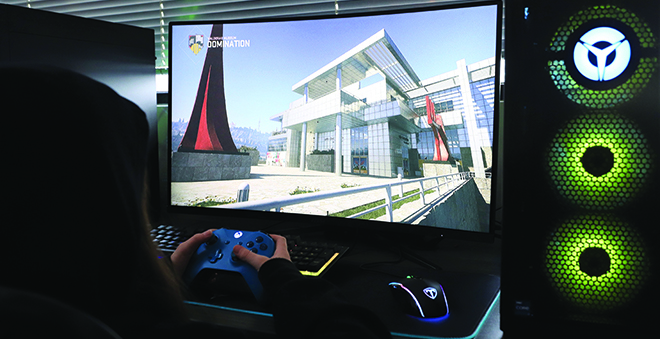
By Micheal Rios, Tulalip News
Since the arrival of high-speed internet and smart phones with more computing power than 1970’s NASA super computers, there has been a growing tech divide among communities who have access to these digital goodies and those who don’t. This divide is most obvious among our youth. There are those who have access to the latest, greatest technology at their fingertips and those who don’t. This divide significantly impacts future learning opportunities and earning potential.
Fortunately, the reservation-centered Boys & Girls Club is staffed by homegrown tribal citizens who are working diligently to close this tech divide for the hundreds of Club kids who attend weekly. Since the Club expansion in 2019, which included a 4000-square-foot multimedia teen center, the evolution of technology accessible to members has grown tremendously. There are six Xbox gaming stations complete with 4k TVs, a dedicated high-speed internet server, and a sound system that rivals most music studios.
Now, the Club is excited to announce the arrival of its latest teen center tech: Legion tower 7i gaming desktops. These next generation gaming computers come preloaded with powerful processors, GeForce RTX graphics cards and future-proof, expansion-ready motherboards. With an approximate retail value of $3,000 per tower, each of the Club’s eight computer stations is designed to deliver the ultimate performance for teenage gamers and digital creators.
“The big picture goal for my staff and I is to provide our Club kids with opportunities they may not have access to at home on a daily basis, like high-speed internet and other upgraded technology they need to tap into digital communities,” explained Club director Shawn Sanchey. “Today, there are so many opportunities for youth to better their future through these technologies. There are college scholarships for e-gaming, professional sports based on digital mediums, and even podcasters and social media influencers making a real good living through sponsorships, endorsements and reviews of new technologies.”
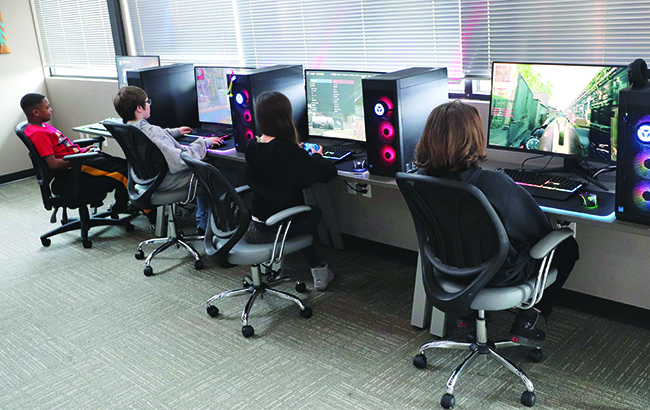
Since the infusion of digital tech and competitive gaming, the world of e-sports has exploded in popularity. While traditional sports like football and basketball have long been the mainstay of Tulalip athletics, e-sports are quickly emerging as a viable alternative for young people looking for an engaging and competitive activity.
As video games have become more sophisticated and accessible, they have gained a massive following. With the development of online multiplayer games, players from all over the world can compete against each other in real-time, creating a sense of community and competition that has never been seen before.
“It was so important for me to be able to help design the computer stations for the kids because there’s so much interest in e-gaming. So much of today’s world is technology and for us to offer these state of the art towers is huge. I wish these were available when I was a Club kid, that’s for sure,” said teen director Anthony McLean. “There are full-ride scholarships and a ton of careers offered now just for playing video games. At the end of the day, its our responsibility to build up the passions and interests of our kids, and for a lot of them today that’s e-sports.”
For many young people, e-sports offer a unique opportunity to pursue their passion for gaming while also participating in a competitive and team-based activity. Rather than simply playing games for fun, they can use their skills and knowledge to compete against other players and strive for victory. This can be an incredibly rewarding experience, as it allows them to develop a sense of mastery and achievement that is difficult to find in other activities.
One of the key factors driving the rise of e-sports among youth is the availability of online resources and communities. There are a plethora of online forums, guides, and videos that offer guidance and advice for aspiring players. Additionally, there are many organizations and communities dedicated to promoting e-sports, which offer opportunities for young people to compete in tournaments, join teams, and connect with other players.
“We’ve been hosting a lot of tournaments and the kids have responded really well to them. I’ve seen the tournaments be a social outlet for some of them, like you’ll see the quiet kids get real engaged and talkative with other kids once they are playing. It’s pretty cool to see the joy and smiles they have because whether they know it or not, this is what community building is all about,” said teen director assistant Magdaleno Vela.
The rise of e-sports can simply be attributed to the changing nature of youth culture as young people have become increasingly connected and engaged with technology. Just as previous generations did and future generations ones will, youth gravitate towards activities that reflect their interests and values. E-sports offer a sense of community and camaraderie that is difficult to find in other activities. In this spirit, Tulalip’s Boys & Girls Club’s next gen computer stations are continuing the long-held tradition of allowing our young people to express themselves and develop their identities in their own unique way.
___________________________________________________________________
Club staff bios
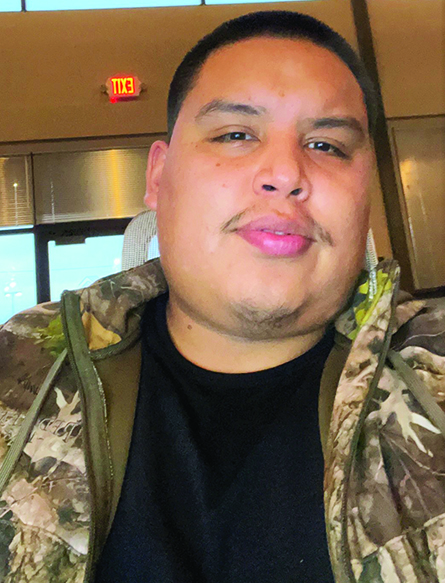
Full name and age: Anthony McLean, I am 26 years of age.
Job title and years of service: Teen Director. Going on 2nd year of service.
Describe your cultural background or heritage: I am a Tulalip tribal member.
What interested you in working at the club? Creating opportunities for all youth, and giving back to my community. It’s important for me to be a positive role model to all the youth.
What is your favorite program currently offered to the kids? My favorite program is either teen night, or the power hour we offer kids. When they first get here they get an hour to catch up on homework or read a book whatever they would like to do.
What program would you like to see made available to the kids and community? The creation of an E-sports team. Here at the Club we have everything they need to be successful within the gaming world. I think starting an E-sports team would benefit every youth that walks through the doors.

Full name and age: My name is Magdaleno Vela. I am 20 years old.
Job title and years of service: I am a Teen Director Assistant and have been working here at the Boys & Girls Club for three and a half years.
Describe your cultural background or heritage: I am Mexican/Native American.
What interested you in working at the club? I came to the club as a kid and wanted to give back to the community.
What is your favorite program currently offered to the kids? My favorite program right now is our teen program. We have a lot of good things going on. We just got brand new PC’s and Xbox’s and we’re having teen nights every other weekend for the teens.
What program would you like to see made available to the kids and community? I would like to see a boxing program. It would be really good for some kids because it could help them learn self-defense and can be an opportunity to go professional one day.
Lydia Mae Lahela Hinsee
September 29, 1987 – March 5, 2023

Tulalip Tribal member, Lydia Mae Lahela Hinsee went to be with the lord March 5th, 2023. She was born to Holliday Hayes and Samuel F. K. Hinsee on September 29th 1987, in Everett, WA. Lydia loved posting her MUOTD (makeup of the day) and playing Pokemon Go where she met her love Sam, the father of her one and only miracle baby Taylor (Tay Tay). Tay Tay was the light of her life, her rainbow baby whom she waited 14 years for. She always updated family and friends about her pregnancy journey and baby milestones on social media for everyone to adore.
She loved collecting LOL Dolls, mini brands , shopkins and squishmallows. She loved binge watching her favorite tv shows and staying up late to talk with her sisters. She enjoyed playing her favorite slots and playing bingo with her family. She also loved photographing scenery. Her motherly instinct was strong, always taking care of numerous babies including her siblings.
Lydia leaves behind her Parents Holliday & Antonio, Daughter Taylor, Son Sammy. Siblings Wanda (Ryan), June, Lola, Jaelarae, Kayden/Alex, Avaughnei and Akela (KeKe) Special sisters Layla, Denise, Jessica Bustad,Teresa, Selena (Walla Walla) and Brother Calvin (Cali-Cal). Numerous Aunts, Uncles, Second mom’s and Nieces & nephews.
She was preceded in death by her Father Samuel F. K. Hinsee, Dad Ronald J. Horne Sr., Great Grandma Marjorie Lydia Henry Hayes, Grandparents Warren and Wanda (Williams) Hayes, Jo Landert and Walter Steinbach, Merle Hayes II, Uncle Victor Nelson Sr. , Brother Troy D. Bradford, Special nephew Kiyaire Leeoni Wilson Flores. And many other family and friends.
An evening service will be held Thursday, March 9, 2023 at the Tulalip Gathering Hall. A celebration of Life will be held Friday, March 10, 2023 at 10:00 am at the Tulalip Gathering Hall with burial to follow at Mission Beach Cemetery.
Tulalip prepares for a cultural summer
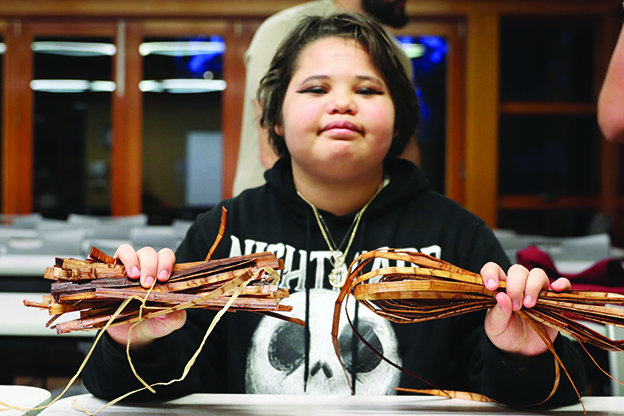
By Kalvin Valdillez, Tulalip News
Nothing quite says summertime for Pacific Northwest tribes more than cedar dugout canoes on the Salish Sea and the return of the king salmon. For as far back as many can recall, the sduhubš people have engaged in cultural activities to celebrate their way of life, immersing into the natural world during the season of sunshine and adventure.
Notably, a time for harvesting traditional foods, plants, and medicine such as huckleberries, cedar, salmon, and shellfish, summer is filled with an abundance of teachings that are important to the tribal nation of Tulalip. The act of exercising their inherent treaty rights and gathering these items is a significant aspect of their culture. And it is frequently celebrated on the reservation during the summer at a number of events including the yearly clambake known as Spee-Bi-Dah and of course, the Salmon Ceremony.
Revived nearly 50 years ago, Salmon Ceremony pays homage to the king salmon for providing nourishment for the tribal community. The ceremony also provides an opportunity for the Tribe to bless the local fisherman who are ready to begin a new season out on the water. During this cultural experience, the people don their beautiful regalia of shawls, vests, ribbon skirts, cedar headbands, and beaded jewelry, and they share traditional songs and stories all in tribute to the king salmon.
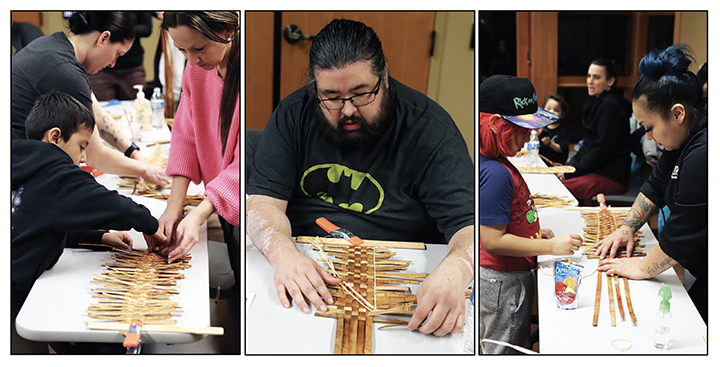
Canoe Journey is another major cultural event that takes place in the late summer months, and it is a beloved gathering celebrated by numerous coastal tribes and first nation bands. For over three decades, tribal families have navigated the local waterways, traveling to handful of reservations before reaching the hosting tribe’s village. The final destination changes annually, as the tribes take turns hosting the event. This year’s paddle ends at Muckleshoot, where a weeklong protocol will ensue, and each tribe and band will offer their traditional family songs and dances to commemorate another successful Canoe Journey.
Equally as important as the teachings that take place at these summertime events is the preparation for those gatherings. In anticipation of this year’s Salmon Ceremony and the 2023 Canoe Journey, Tulalip tribal members of all ages joined together for the Tribe’s first Cultural Night of the year on the evening of March 7. Numerous families attended Cultural Night where they received a shawl kit and bundles of cedar to craft their own regalia.
During Cultural Night, Tribal member, Melissa Gobin was on hand to assist the people with their projects. She stated, “We’re trying to get more people involved in Salmon Ceremony and Canoe Journey and ensure that they have regalia to dance. We’re also trying to get more elders to volunteer to talk to the little ones, and help the people understand the importance of why we come together in this way as a community. It really makes me happy to see everybody working on their projects. And, you know when you make your own regalia, it makes you that much more proud when you’re wearing it.”
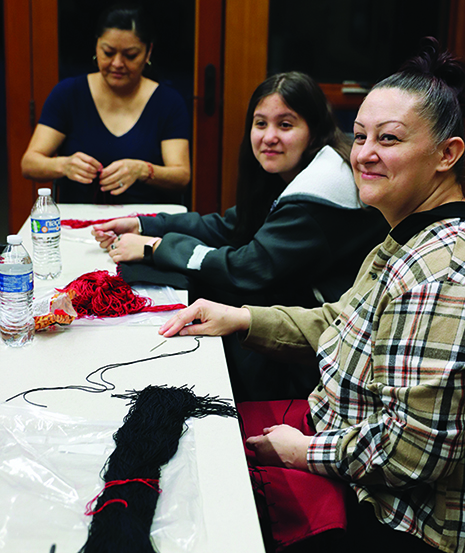
She continued, “Tonight, we’re doing shawls, headbands, and cedar belts. So, we’re trying to incorporate as much of our traditional teachings as we can for the regalia. We’re also going to be doing some ribbon skirts in the future, and vests for the men.”
Occupying all three classrooms of the Hibulb Cultural Center, there were close to seventy-five people in attendance. In fact, there were so many participants at the gathering that the Tribe is considering bigger venues to host the remaining eighteen Cultural Nights this year. It was beautiful to see Tulalip’s ancestral teachings passed down to the younger generations in real-time. Many families attended the event together and were happy to share time and conversation while working on their traditional attire.
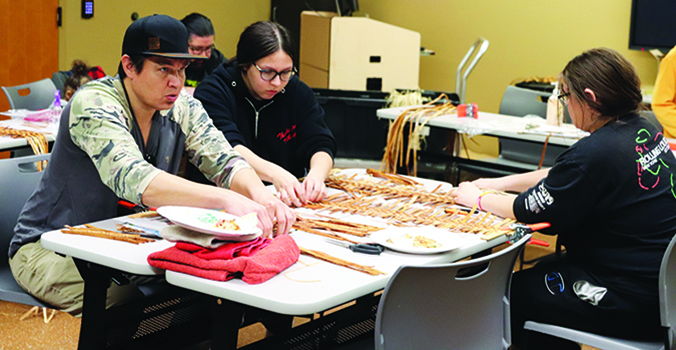
“I have a daughter who was born in 2020, so I really want her to be able to access community in a way we haven’t since she was born,” shared Shayleigh Tucker. “I am making my shawl and we’re waiting for the baby sized shawls, so we can make one for my daughter as well. My sister is working on her shawl, and she’s going to grab some cedar and start cedar belts.”
Everywhere you looked, it was bright smiles and plenty of laughter as the community caught up with each other during the two-hour event. Tulalip pride was on full display as many of the participants shared their excitement to wear their handmade regalia at both the Salmon Ceremony and also along the Canoe Journey’s Paddle to Muckleshoot. Newcomers quickly picked up on the techniques of weaving and sewing, and are already eager to learn more and take on new projects.
Said Melissa, “Seeing my nieces, my friends and new faces, and seeing a dad who brought his daughter out to make a shawl, makes me so happy. I think that in this new generation, some of them don’t even know what a shawl is, and so we’re bringing the teachings to them. And we’re telling them that we are going to teach you these things so that you know what to do when we’re having our ceremonies and what it means to be Tulalip.”
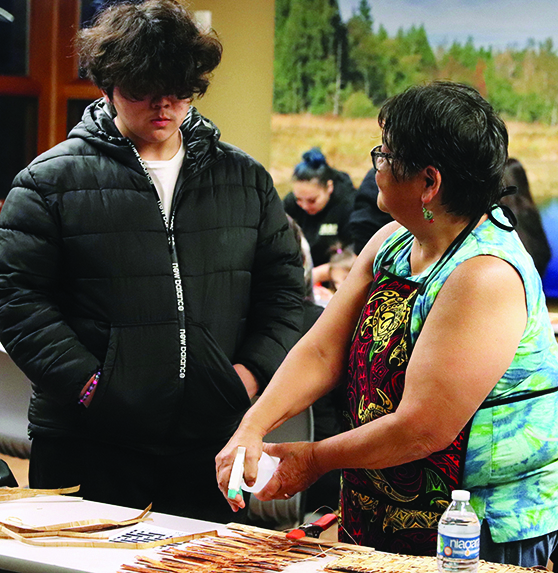
Cultural Nights are planned for every Tuesday, from 5:30 p.m. to 7:30 p.m., leading up to the Canoe Journey this July. The Cultural Night gatherings are also exclusive to Tulalip tribal members. And make sure to keep an eye out for a location change as more people confirmed on Facebook that they will be attending Cultural Nights in the upcoming weeks.
While working on a cedar belt, which she plans to gift upon completion, Tulalip Youth Council Vice-Chair, Faith Valencia, expressed, “It’s important to keep the culture alive so we can pass it on to future generations to keep it going,”
For additional information about Cultural Nights, please contact Malory Simpson at (360) 716-4399.
“You can move mountains with just a pebble a day”: Tulalip’s newest force in environmental work
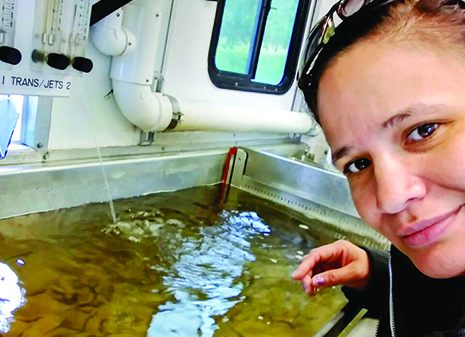
By Shaelyn Smead; photos courtesy of Teesha Osias
Protecting Mother Earth is a priority for Native Americans and many environmental justice groups. Tulalip tribal member Teesha Osias is enhancing the Native presence in environmental work by reinventing herself and investing in her future.
From 1999 to 2022, Teesha overcame many obstacles and worked diligently to receive an education. She earned an Associate of Arts, Associate of Applied Science, and Bachelor of Science in Native Environmental Science from Northwest Indian College (NWIC). Her education has taught her to uphold treaties and inherent rights by protecting the natural world. She took on holistic training in Native Environmental Science through Indigenous research and content knowledge. After 23 years of sacrificing her time, efforts, and mental state, she achieved something great; an education, a future for her family, and paving a path for future Native biologists.
However, Teesha didn’t always have the confidence to reach her goals. She shared about her difficult childhood and its lack of stability. Her family moved so often that adjusting to each new school’s curriculum became difficult for her. Eventually in her teens, between falling behind in school and running with the wrong crowd, Teesha withdrew and enrolled with Job Corps.
“School was never easy for me. I felt like I was always struggling. But I finally felt comfortable with Job Corps and like I could achieve more. It started a little fire in me. They gave me the tools and things necessary to believe in myself again.”
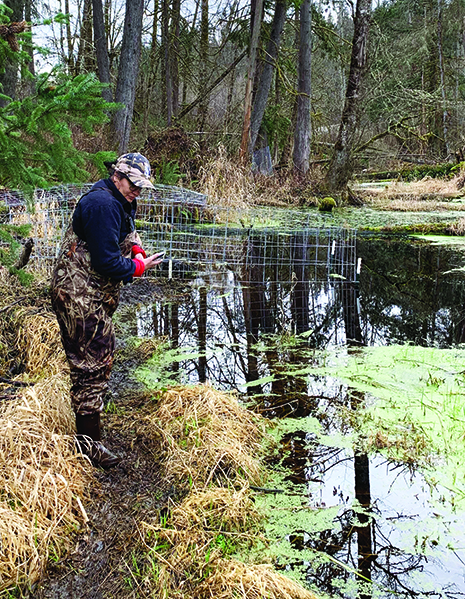
At 20 years old, Teesha decided to return to school and earn her GED. Teesha remembered speaking with a teacher about becoming a Biologist and the unwavering look she received from them. Even though it was clear her teacher didn’t believe in her, she believed in herself. Venturing into the science world always seemed like a forbidden concept, but she knew she would eventually get there by accomplishing small goals at a time.
Unfortunately, Teesha’s struggles didn’t stop there. While in college, she dealt with troublesome relationships, homelessness, and raising three kids. She felt like she was in survival mode. At many points, she wanted to quit and even spoke about ripping up her papers and textbooks out of defeat. Finally, what felt like a light at the end of the tunnel, a friend offered her a job working on their fishing boat.
“I fell in love with the work. It was empowering, and it saved me. I remember hearing other tribal members speak about why our voice is important regarding our land and fish and how we needed more Natives in the Natural Resources department. The experience reignited my passion for biology and reminded me of what I was doing this for. I didn’t want to let my community down. I wanted to continue my education to help my people and not have that ‘what if’ feeling looming over my head. Plus, I had six little eyeballs [her kids] watching me. What would that be teaching them?”
Being a single mom and working full-time, Teesha had a heavy load. Additionally, the NWIC Tulalip satellite location could only partially provide certain science lab technology and tools required for her classwork and had to rely on other sources. With these obstacles, she sometimes took as little as one course per school quarter to keep inching toward her degree.
“Many people would poke fun at me, calling me a ‘professional student’ and would give me grief for taking so long to finish school. But you have to fight for what you want, and that’s exactly what I did. You can move mountains with just a pebble a day.”
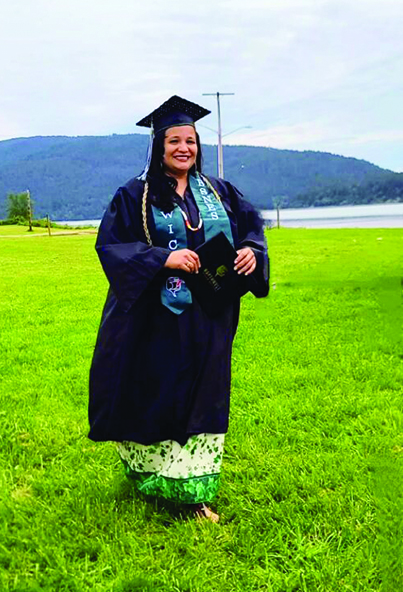
Teesha expressed how NWIC helped her find her Indigenous voice. They educated her on food sovereignty, treaty and fishing rights, basket weaving, and other cultural knowledge. She was exposed to new books by Native authors that impacted how she saw the world and the importance of Indigenous mentalities. Concepts that combined modern-day environmental solutions with the Native traditional ways of life.
While Teesha earned her degree, she spent much time interning in different areas within Tulalip Natural Resources. She helped work on lumber management in forestry, collecting milt and acting as a fish technician in the hatchery, measuring and evaluating geoducks by the bay, assisting on the Elwha Dam removal project, spearheading many environmental surveys and projects, and helping Wetland Program Coordinator Allison Warner and Environmental Wetland Biologist Michelle Bahnick on wetland preservation and land development.
“This work feels a part of me like it’s in my DNA. I know this work’s importance and think this connection manifested through my ancestors. It makes such a difference when you touch your land. We belong out here doing what Indians do.”
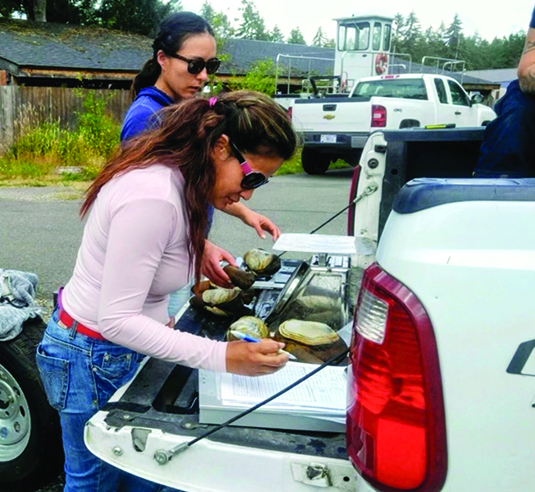
Working closely with nature, preserving the environment, and identifying climate indicators have played a significant factor in Native American culture. Even though Teesha grew up in the city, being involved in this field has given her new life. She knows there is still plenty of room to grow and learn and expressed her gratitude to Allison and Michelle for allowing her to take her ‘training wheels’ off.
Allison spoke of her time with Teesha and her hopes for more tribal members to get involved with environmental departments, “It has been a pleasure working with Teesha. Her story is inspirational. I’m excited to think that in the future, more tribal scientists will be filling these roles in our natural resources departments .”
Amid everything, Teesha has also taken opportunities to work with Native youth to teach them about the wetlands and will be helping plant trees with Native students later this month. She is impacting Native students by exposing the many paths of environmental work. She’s a living example that scientific careers are attainable for Native youth and inspires them to get involved. She speaks of her dreams where her people come together and play a dominant role in every department to take care of our home again.
Teesha is a great example of how powerful perseverance and patience can be. Despite the many reasons life gave her to quit, Teesha had the tenacity to continue being the force she was and continues to be.